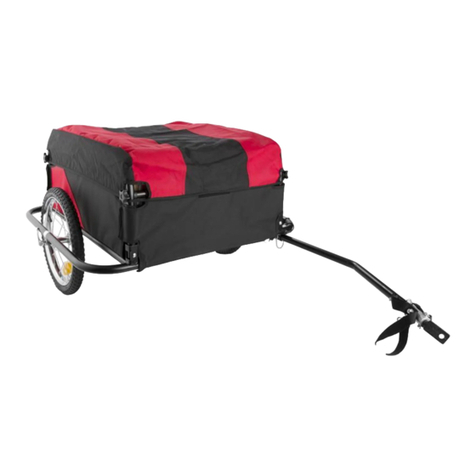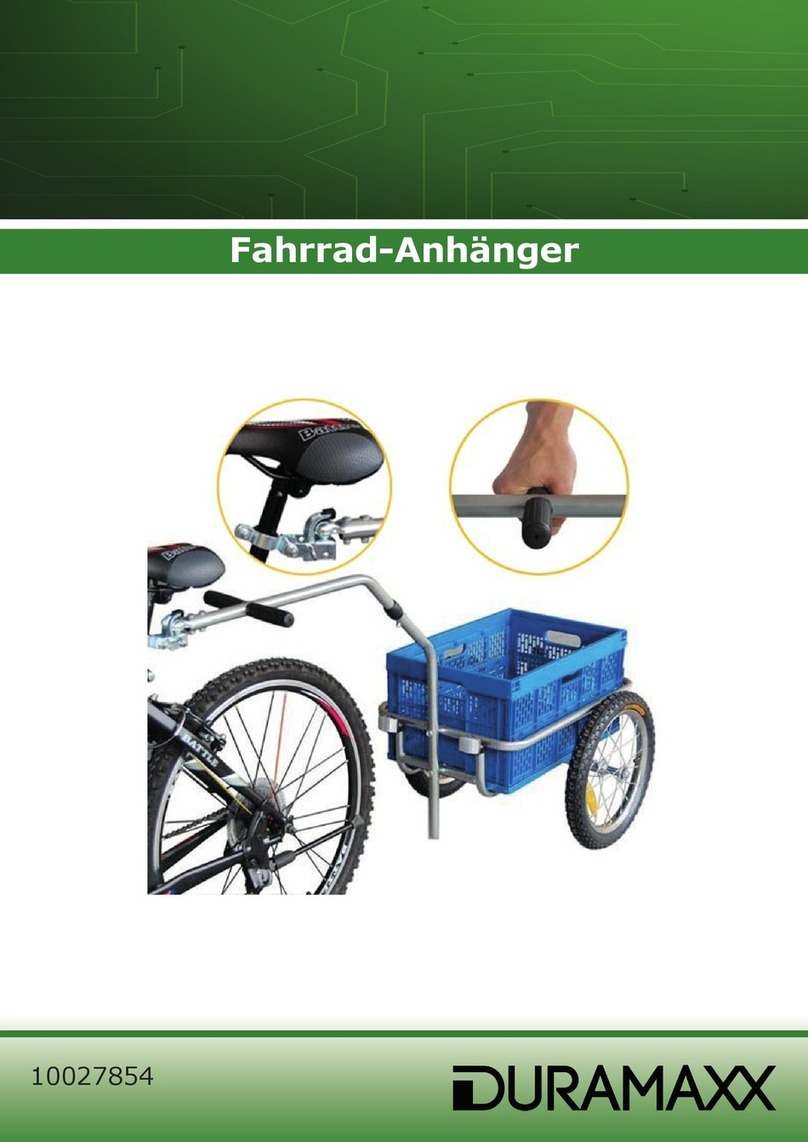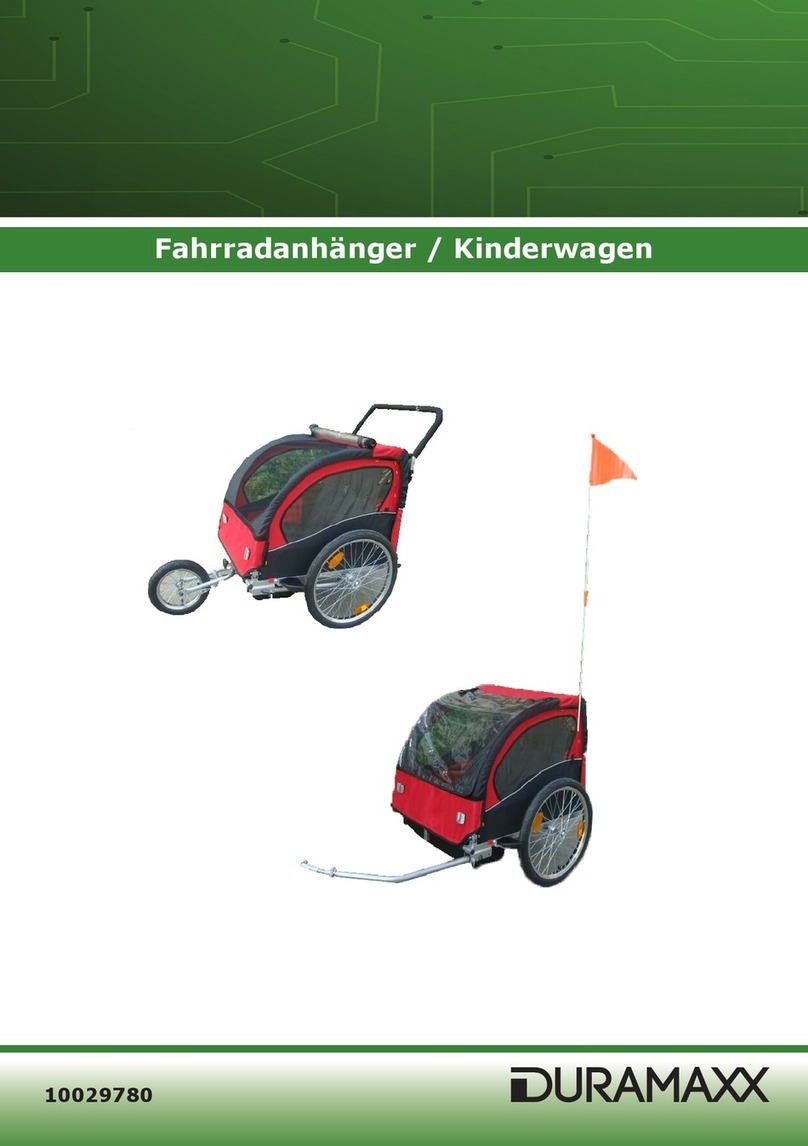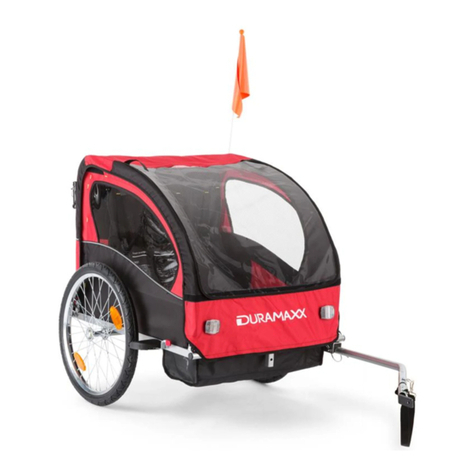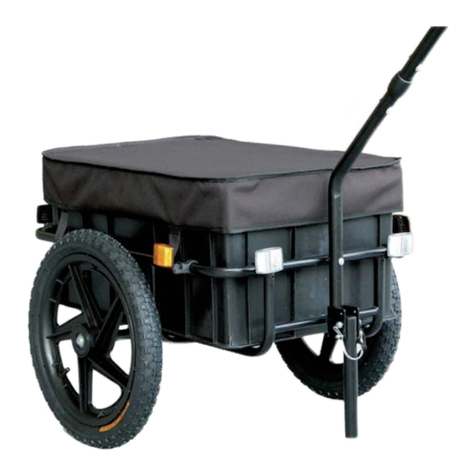Duramaxx 10027857 User manual

10027857
Fahrrad-Anhänger

2
Sehr geehrter Kunde,
Wir gratulieren Ihnen zum Erwerb Ihres Gerätes. Lesen Sie die folgenden Anschluss- und Anwendungs-
hinweise sorgfältig durch und befolgen Sie diese, um möglichen technischen Schäden vorzubeugen.
Für Schäden, die durch Missachtung der Sicherheitshinweise und unsachgemäßen Gebrauch entstehen,
übernehmen wir keine Haftung.
Technische Daten
Artikelnummer 10027857
Empfohlene Höchstgeschwindigkeit 16km/h
Maximales Ladevolumen 70 x 57,5 x 32 cm
Zulässige Beladung 60kg
Sicherheitshinweise
• Der Anhänger darf nicht mit mehr als 60kg beladen werden.
• Die empfohlene Höchstgeschwindigkeit beträgt 16km/h.
• Der Anhänger darf nicht benutzt werden, um Personen damit zu befördern.
• Führen Sie keine technischen Modikationen am Gerät durch. Dies kann zu Gefahren im Straßenver-
kehr führen und die Herstellergarantie erlischt.
• Tragen Sie immer einen Helm.
• Nutzen Sie den Anhänger nicht auf steinigem, unebenem Gelände und in gefährlichen Verkehrssitu-
ationen.
• Das ziehende Fahrrad muss in einwandfreiem Zustand sein. Die Bremsen sollten perfekt funktionie-
ren.
• Mit Anhänger (und Beladung) verlängert sich Ihr Bremsweg.
• Beladen Sie den Anhänger nur bis zur Oberkante, damit nicht herausfallende Dinge den Straßenver-
kehr gefährden.
Zusammenbau
Schritt 1: Die Räder anbringen
• Entfernen Sie die zwei Schutzkappen an jedem Rad.
• Schrauben Sie vom Schnellspanner (siehe links) die Teile ab, die hier mit „innen“ gekennzeichnet sind
und schieben Sie den den Schnellspanner zusammen mit den mit „außen“ markierten Teilen durch
die Radachse.
• Nehmen Sie eines der Räder zur Hand und plat-
zieren Sie es so an der Seite des Anhängerrah-
mens, dass der Stab des Schnellspanners durch
die Führung im Rahmen geleitet wird.
• Achten Sie darauf, dass der Hebel des Schnell-
spanners an der Außenseite und daher zugäng-
lich bleibt.
• Bringen Sie nun die mit „innen“ markierten Tei-
le an der ‚inneren‘ Seite des Schnellspanners an
und ziehen Sie die Mutter nur so weit an, dass
der Schnellspanner noch ‚Luft‘ hat.

2 3
• Ziehen Sie diesen nun stramm an, indem Sie den Hebel in eine mit dem Rahmen parallele Position-
bringen. Klappt das nicht, oder nur mit großem Kraftaufwand, haben Sie die Mutter bereits zu stark
angezogen. Lösen Sie sie ein wenig und wenden Sie bei der Montage keine übermäßige Kraft an.
• Wiederholen Sie die Prozedur ebenso auf der anderen Seite.
Achtung: Achten Sie darauf, dass die Unterleg-
scheiben jeweils in den entsprechenden Ausspa-
rungen im Rahmen Platz nden und die Räder nur
minimales Spiel haben.
Schritt 2: Die Zugstange anbringen.
• Um die Zugstange zu xieren, stecken Sie zunächst das runde Ende in die Aufnahme an der linken
Anhänger-Vorderseite (Bild 1).
• Sichern Sie die eingesteckte Stange mit dem mitgelieferten Spanner (Pos. a) und dem Sicherheitsstift
(Bild 2).
• Die Krümmung der Zugstange sollte nun nach rechts (in Fahrtrichtung) zeigen.
Achtung: Stellen Sie sicher, dass die Zugstange sicher mit dem Anhänger verbunden ist. Eine lose Zug-
stange kann dazu führen, dass Sie die Kontrolle über den Anhänger während der Fahrt verlieren und so
zu einer Gefahr im Straßenverkehr werden.
Schritt 3: Den Anhänger aufklappen
• Stellen Sie den Anhänger normal auf den Boden und heben Sie die Seitenpaneele an, bis diese in
vertikaler Position stehen.
• Bringen Sie nun die Stange am Frontpaneel in eine Linie mit den Rahmenstangen (siehe Foto).

4
• Schrauben Sie die Stange mit den beiden Schrauben (mit Sternförmigen Griffen) am Rahmen fest:
Schritt 4: Die Sicherheitsfahne einsetzen
An der hinteren linken Ecke des Anhängers bendet sich die Aufnahme für die Fahrnenstange. Ste-
cken Sie die Fahne hier ein, wenn Sie mit dem Anhänger unterwegs sind. Dies ist eine einfache aber
effektive Sicherheitsmaßnahme für den Straßenverkehr, denn die Fahne macht Sie sichbarer gegen-
über anderen Verkehrsteilnehmern.
Schritt 5: Den Anhänger am Fahhrad befestigen
A - Fahrräder mit fester Achse
• Entfernen Sie die linke(!) Mutter, mit der die Radnabe am Rahmen aufgehängt ist. Eventuell vor-
handene Unterleg- oder Distanzscheiben können normalerweise problemlos durch den Haken der
Zugstange ausgetauscht werden.
• Streifen Sie den Haken über die Achse und schrauben Sie sie wieder mit der Mutter fest. Ach-
tung: Sie müssen die Mutter mindestens 5 mal vollständig drehen können, damit eine genügend
stabile Verbindung sichergestellt ist. Ist das Gewinde dafür nicht lang genug, kann dies zu Unfäl-
len und Stürzen führen (wenn sich das Hinterrad während der Fahrt löst).
B - Fahrräder mit Schnellspannern
• Schrauben Sie den Schnellspanner wie eine Mutter der Hinterradnabe ab und stecken Sie den
Haken zwischen Fahrradrahmen und Hinterradnabe (wie eine zusätzliche Unterlegscheibe).
Schrauben Sie das Hinterrad ihres Fahrrades
wieder fest. Der Haken sollte, wie in der Abbil-
dung zu sehen, mit dem ‚männlichen‘ Teil nach
hinten zeigend und vom Fahrrad weg zeigend
angebaut werden.
Stellen Sie den Hänger hinter das Fahrrad und
integrieren Sie das ‚männliche‘ Stück in die
dafür vorgesehene Öse (‚weibliches Teil‘, siehe
Abbildung).
Sichern Sie in beiden Fällen die Verbin-
dung mit dem Sicherheitsgurt, indem Sie
diesen einmal um den Fahrradrahmen wi-
ckeln (achten Sie darauf, dass er nicht in
die Speichen gerät) und am Hänger-Teil
der Ziehstange befestigen.

Hersteller
CHAL-TEC GmbH, Wallstraße 16, 10179 Berlin, Deutschland
4 5

6
Dear Customer,
Congratulations on purchasing this product. Please read and follow these instructions, in order to avoid
damaging the item. We do not cover any damages that may arise from improper use of the item or the
disregard of the safety instructions.
Technical Data
Article no. 10027857
Maximum rated load 60kg
Speed limit 16kph
Maximum load volume 70 x 57,5 x 32 cm
Safety Instructions
• Do not exceed the trailer ’s permitted maximum weight of 40 kg.
• The trailer must not be used to transport passengers.
• Do not carry out technical modications of any kind on the trailer.
• Do not attempt to carry additional loads on the tow bar.
• Maximum road speed: 10 mph (16 km/h)
• Do not use the trailer on stony or uneven road surfaces, or in road conditions otherwise considered
dangerous.
• Proceed with great care when on public roads in order to avoid hazards.
• The person riding the towing bicycle must be at least 18 years of age and in a t state to be in charge
of a vehicle.
• Ensure that the towing bicycle is in a perfect state of repair.
• Check all components for tightness before each trip, paying particular attention to the quick-action
coupling and wheels.
• Please note that we cannot accept liability for accessories obtained from other suppliers.
• Only bicycles must be used as towing vehicles. The cycle used must be specically identied in its
manufacturer ’s instructions as being suitable for towing purposes.
• Ask your specialist dealer to check that the brakes are capable of towing the trailer.
• Never load the trailer to above the top edge of the side rails, as falling objects may endanger other
trafc.
• Load the trailer to its maximum capacity and practice towing it on an enclosed piece of land before
venturing out onto public roads. Take special care to practice riding around bends and up and down
slopes, and try out your emergency-braking and setting-off techniques on different road surfaces.
• Note that there is an increased risk of tipping over when stationary when the trailer is attached
• Ensure at all times that the towing bicycle is in a t state to tow the loaded trailer.
• Push the load well inside the trailer or otherwise secure it to prevent loss.
Assembly
Step 1: Attaching the wheels
Remove the two black protective caps on each wheel.
Unscrew the parts marked” inside“ in the picture from the quick-action tension jack and push the
quick-action tension jack together with the parts marked “outside“ through the wheel axle.
Take one wheel and position it in the guide way provided in the frame in such a way as to ensure that
the quick-action tension jack lever is located on the outside of the trailer. Now, remount the parts
marked „inside” onto the quick-action tension jack, observing the sequence shown in the picture and
then tighten it.

6 7
Please proceed along the same lines on the opposi-
te side with the other wheel.
PLEASE NOTE: Ensure that the retaining washers
(a) are positioned in the recesses in the frame.
Step 2: Installing the Tow Bar
In order to x the tow bar push the round end into the receptacle provided (Figure 1) on the left-hand
side of the trailer. Secure the inserted tow bar with the quick-action tension jack supplied (Pos.a) and
the locking pin (Figure 2).
The bend in the tow bar is now facing the right with respect to the direction of travel.
Important: Ensure that the pin is securely locked, because a loose tow bar could result in your lo-
sing control of the trailer while riding.
Step 3: Unfolding the Trailer
With the trailer frame lying at, raise the side panels so that they are vertical. Position the roll bar
into place until the holes in the side panels and the holes on the ends of roll bar are line up.
Insert the knob from outside of the side panel and then into the thread on the end of the roll bar.

8
Repeat for the other side and fully tighten both knobs.
Attaching the Safety Flag
Insert the ag pole into the ag pocket on the left rear corner of the side panel. Always use the safe-
ty ag. It’s an essential safety device, which can help make you more visible to motorists and other
cyclists.
Step 4: Hitching the Trailer on the Bicycle
NOTE: The universal hitch is only suitable for bicycle with full axle or/and with quick release axle.
A- Bicycles with Full Axle
Remove the left hand axle nut from the bicycle. Any spacers or washers can generally be retained.
Put the hitch on the axle and re-attach the nut.
WARNING: The axle nut must be tightened on the axle thread by at least 5 full turns, so that ade-
quate clamping force is ensured. A thread which is too short can result in accidental loosening of the
rear wheel and therefore cause serious injury or death. If in doubt, contact your specialist dealer.
B - Bicycles with Quick Release Axle
Remove the quick release from the bike and guide it through the hitch along with the quick release
axle. Push the quick release through the wheel hollow axle again, screw the nut and clamp the quick
release with the correct pressure.
In order to ensure that the hub is clamped sufciently in the hollow axle, the quick release lever must
begin gripping as it moves from the open to the middle position, and approaching the closed position
you should clearly feel resistance as you tighten. If it is too easy or too difcult to move the quick
release lever, tighten or loosen the quick release nut on the other side of the hub.
WARNING: The thread of the quick release nut must be tightened on the quick release axle by at
least 5 full turns, so that adequate clamping force is ensured. A quick release axle with is too short
can result in accidental loosening of the rear wheel and therefore cause serous injury or death. If in
doubt, contact your specialist dealer.
Insert the safety pin through holes in both hitch and hitch connectors. Rotate and lock up
the pin. Wrap the safety strap around the chain stay and fasten it to the tow bar D-ring
with the snap hook.
WARNING! Hitch and safety strap must be properly installed. Inspect the hitch and tow
bar frequently for any damage or loose fasteners. Damaged or improperly installed can
result in serious injury or death.

8 9
Manufacturer / Importer
CHAL-TEC GmbH, Wallstraße 16, 10179 Berlin, Germany

10
Chère cliente, cher client,
Toutes nos félicitations pour l’acquisition de ce nouvel appareil. Veuillez lire attentivement et respecter
les consignes suivantes de branchements et d’utilisation pour éviter d’éventuels dommages techniques.
Fiche technique
Numéro d’article 10027857
Vitesse maximale recommandée 16km/h
Volume de chargement maximal 70 x 57,5 x 32 cm
Charge supportée 60kg
Consignes de sécurité
• La remarque de vélo ne doit pas être chargée de plus de 60 kg.
• La vitesse maximale recommandée est de 16 km/h.
• La remorque ne doit pas servir à transporter des personnes.
• Ne pas effectuer de modications techniques sur l’attelage. Ceci pourrait engendrer des dangers sur
la voie de circulation et annulerait la garantie du fabricant.
• Toujours porter un casque de protection.
• Ne pas utiliser la remorque sur des terrains caillouteux et irréguliers, ni dans des situations de circu-
lations dangereuses.
• Le vélo qui tire la remorque doit être dans un état irréprochable. Les freins doivent fonctionner par-
faitement.
• Le temps de freinage est plus long avec la remorque (et son chargement).
• Charger la remorque uniquement jusqu’au rebord supérieur pour éviter que des objets n’en tombe
sur la voie de circulation.
Montage
Étape 1 : monter les roues
• Enlever les deux capuchons de protection de chaque roue.
• Démonter les pièces de l’attache rapide marquées « intérieures » sur l’image ci-dessous et enlever
l’attache rapide marquée « extérieure » de l’essieu de la roue.
• Prendre une des roues et la placer sur le côté
du cadre de la remorque, de sorte à ce que la
tige de l’attache rapide passe dans le trou du
cadre.
• Veiller à ce que le levier de l’attache rapide
reste sur le côté extérieur et reste accessible.
• Fixer les pièces marquées « intérieures » au
côté intérieur de l’attache rapide et ne pas visser
les écrous encore complètement, pour laisser un
peu de « jeu » à l’attache rapide.
• Tendre à présent l’attache rapide en ramenant

10 11
son levier à une position parallèle au cadre. Si cela ne fonctionne pas, ou s’il est nécessaire de
forcer pour y arriver, c’est que les écrous ont été trop serrés. Les desserrer un peu et ne pas faire
usage de violence pour aucune des opérations du montage.
• Répéter l’opération pour l’autre côté.
Attention : veiller à ce que les rondelles soient
toujours placées dans les encoches adéquates du
cadre et que les roues n’aient plus que très peu
de jeu.
Étape 2 : monter le timon
• Pour xer le timon, en introduire l’extrémité arrondie dans le tube situé à l’avant de la remorque,
du côté gauche (image 1).
• Bloquer le timon introduit avec la goupille de tension fournie à la livraison (Pos. a) ainsi que la
goupille de blocage (image 2).
• La courbure du timon doit alors être orientée vers la droite (dans le sens de circulation).
Attention : s’assurer que le timon est bien solidaire de la remorque. Un timon lâche peut provoquer une
perte de contrôle de la remorque pendant la conduite et provoquer ainsi un accident de la route.
Étape 3 : déplier la remorque
• Placer la remorque au sol normalement puis relever les panneaux latéraux à la verticale.
• Aligner les trous de la tige avant avec ceux des tiges du cadre (cf. photo)
• Visser la tige en la xant au cadre à l’aide des deux vis (avec poignées en forme d’étoile).

12
Étape 4 : xer le drapeau de sécurité
Dans le coin arrière gauche se trouve un trou prévu pour la tige du drapeau. Y introduire le drapeau
pour circuler avec la remorque. Ceci est une mesure de sécurité simple mais efcace vis-à-vis de la
circulation routière, car le drapeau rend le cycliste plus visible aux autres.
Étape 5 : attacher la remorque au vélo
A - Vélos avec essieu xe
• Dévisser l’écrou gauche ( !) qui xe le moyeu de la roue au cadre. Normalement, il est éventuel-
lement possible de remplacer sans problème les rondelles et les pièces d’écartement au niveau
du crochet du timon.
• Fixer le crochet au timon et revisser l’écrou. Attention : il est nécessaire de visser l’écrou sur au
moins 5 tours complets pour garantir un raccordement stable et sûr. Si le pas de vis n’est pas
sufsamment long, cela peut provoquer un accident et une chute (si une roue arrière se détacher
pendant la circulation).
B - Vélos avec attache rapide
• Dévisser l’attache rapide comme un écrou du moyeu arrière et se servir du crochet pour attacher
le cadre du vélo avec le moyeu arrière (qui sert de rondelle supplémentaire).
• Revisser la roue arrière du vélo. Le crochet doit être dirigé vers l’arrière, comme illustré ci-contre,
et vers l’extérieur.
• Mettre la remorque derrière le vélo et introduire la pièce « mâle » dans l’œillet (cf. illustration).
Dans tous les cas, garantir la xation
avec la sangle de sécurité en l’enroulant
au cadre du vélo (veiller à ce qu’elle ne
se prenne pas dans les rayons) et en la
xant à la partie remorque du timon.

Fabricant
CHAL-TEC GmbH, Wallstraße 16, 10179 Berlin, Allemagne
12 13
Other manuals for 10027857
1
Table of contents
Languages:
Other Duramaxx Bicycle Accessories manuals
Popular Bicycle Accessories manuals by other brands

Specialized
Specialized Elite CylcoComputer user manual

Sigma
Sigma BC 16.16 manual

Playcore
Playcore Dero Setbacks installation instructions

VDO Cyclecomputing
VDO Cyclecomputing x3dw instruction manual

Cateye
Cateye RAPID X2 manual

buratti meccanica
buratti meccanica Clorofilla Trail Use and maintenance manual
